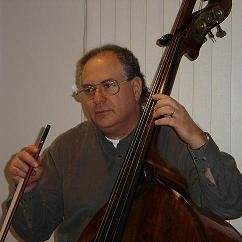Bob Taffet began his journey toward PROSE® in 1972, as a young musician just beginning his professional career as a classical bass violinist. He had trouble reading music, so he made an appointment with his ophthalmologist who diagnosed astigmatism. Bob received a prescription for eyeglasses. Unfortunately, the eyeglasses didn’t help at all.
his ophthalmologist who diagnosed astigmatism. Bob received a prescription for eyeglasses. Unfortunately, the eyeglasses didn’t help at all.
He went to Dr. Charles Pereira, an ophthalmologist at Columbia Presbyterian, who had worked with him as a child to correct his strabismus. Dr. Pereira immediately diagnosed Bob with keratoconus – a progressive condition where the cornea thins and bulges, often into a conical shape. He had keratoconus in both eyes, with the left eye more pronounced. He explained that keratoconus can remain mild but also could become progressively worse.
“The distance at which orchestra bass players need to be able to read tiny print on music sheet requires near fighter pilot vision which I no longer had. The thought that I might have to give up my dream of becoming a performing musician was deeply depressing,” he says.
RGPs for Keratoconus Treatment
The treatment at that time was to wear rigid gas permeable (RGP) contact lenses, as these effectively “resurface” the cornea by presenting a symmetrical shape to the outside of the eye and have a prescription that corrects the astigmatism. Dr. Pereira sent Bob to a colleague who was skilled at measuring and dispensing RGP lenses for keratoconus patients.
Bob was told if the condition progressed to the point that he could no longer tolerate the lenses, the next step would be a cornea transplant, a procedure that had been steadily improving since it was pioneered in the early 1960s and was achieving high success rates. And while the prospect of transplantation was unspeakably frightening, he says, he adopted an optimistic outlook and trusted that professionals could shepherd him through his keratoconus journey.
“I will never forget the first time I put them [RGPs] in at home. I looked down and saw, for the first time in a long time, the weave in my trousers. And then, when I looked up, I saw individual leaves on the trees. It was an emotional moment. And for the next seven years I experienced nearly twenty-twenty vision in both eyes.”
Keratoconus Progression and a Corneal Transplant
Unfortunately, Bob’s condition progressed in his left eye until, in 1979, he required a cornea transplant. After the operation he was left with significant astigmatism in his left eye, but it was fully corrected with an RGP lens. He wore RGP lenses full time in both eyes and experienced excellent vision until 1990 when the keratoconus in his right eye progressed and he underwent a cornea transplant in that eye. Once again, with RGP lenses, his vision was restored to near 20/20.
As the transplanted corneas started to age, his RGPs became less and less comfortable. Bob relied on eyeglasses, part-time, to give his corneas a rest from the RGPs. But with eyeglasses, he could only achieve 20/60 vision. In the mid-2010s, he developed cataracts and in 2017 he underwent cataract surgery. Unfortunately, after cataract surgery, his corneas had degraded to the point that he could no longer be fitted for RGP lenses and the best vision he could get from eyeglasses was 20/80, which left him significantly impaired.
At this point, Bob says, he had two options: the first was to have another cornea transplant in each eye; the second was to try PROSE. PROSE devices rest on the sclera of the eye and create a chamber above the cornea that is filled with a preservative-free saline solution. These devices, like the RGP lenses, create a symmetrical corneal shape and have a prescription, too.
Finding PROSE Treatment
His ophthalmologist referred him to Dr. Corina Busuioc, a PROSE Provider at Northwell Clinic in Great Neck Long Island. Bob’s first PROSE appointment was not unpleasant at all, he says.
“I will never forget Dr. Busuioc inserting the first trial lens in my left eye to begin fitting me. The PROSE lenses were instantly effective. I looked up and was able to read the print on a computer screen on the other side of the room. Not only that, but it was so comfortable, that, unlike RGP lenses, I could not even feel anything in my eye at all. She tried a few more trial lenses and then ordered a custom pair from BostonSight. I remember that in one eye, she nailed it on the first try. The other lens needed a minor change which she reordered. And that was that.”
In 2021, Dr. Busuioc relocated to North Carolina with her family, so now Bob makes an annual 5-hour drive to see Dr. Alan Kwok at BostonSight in Needham.
“My experience with the PROSE lenses has been so positive that I actually look forward to these trips. PROSE has allowed me to prolong the life of my cornea transplants, seven years and counting. My ability to have perfect vision has been restored. I lead a normal, busy, and fulfilled life just as I have always had. Without PROSE I would be facing the uncertainty of further surgeries and potential complications.”
Living with PROSE
As Bob’s corneas continue to age, however, he has had to make minor adjustments. For the first three years he wore his PROSE devices 10 hours at a time. However, as his cornea transplants thin with age, he has reduced his PROSE wear to a maximum of five hours at a time. With a two-hour break in between, he can then wear them for another five hours. “So, when I need my good vision, I have to plan my day accordingly.”
Bob says, “I feel incredibly grateful to the thousands of doctors, surgeons, scientists and technicians who have worked so diligently over past decades developing technologies that have allowed me to lead a completely normal life.”